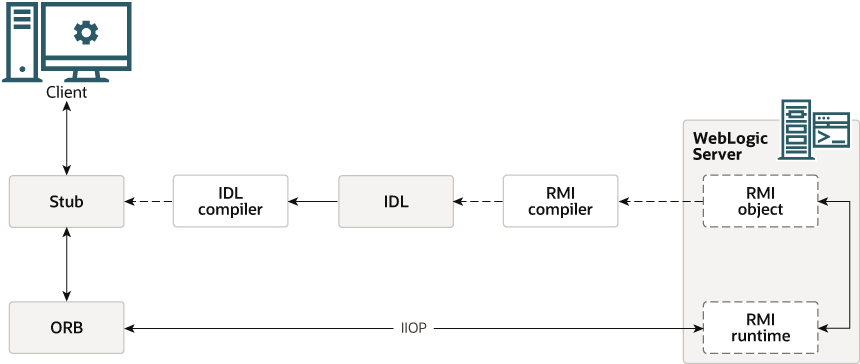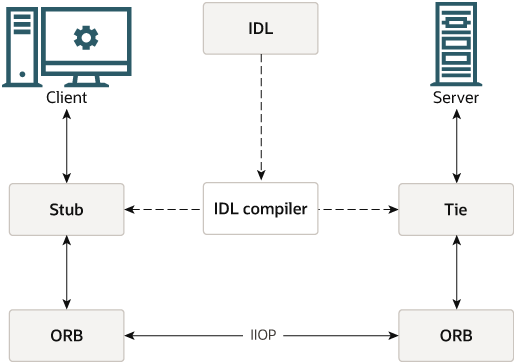4 Developing a CORBA/IDL Client
This chapter includes the following sections:
- Guidelines for Developing a CORBA/IDL Client
Using RMI-IIOP with a CORBA/IDL client enables interoperability between non-Java clients and Java objects. If you have existing CORBA applications, you should program according to the RMI-IIOP with CORBA/IDL client model. Basically, you will be generating IDL interfaces from Java. Your client code will communicate with WebLogic Server through these IDL interfaces. This is basic CORBA programming. - IDL Client (Corba object) relationships
Learn how the IDL takes part in the RMI-IIOP model. - WebLogic RMI over IIOP object relationships
Learn about the object relationships when using RMI-IIOP to connect a client and server. - Procedure for Developing a CORBA/IDL Client
Learn how to develop RMI over IIOP application with CORBA/IDL.
Guidelines for Developing a CORBA/IDL Client
Using RMI-IIOP with a CORBA/IDL client enables interoperability between non-Java clients and Java objects. If you have existing CORBA applications, you should program according to the RMI-IIOP with CORBA/IDL client model. Basically, you will be generating IDL interfaces from Java. Your client code will communicate with WebLogic Server through these IDL interfaces. This is basic CORBA programming.
The following sections provide some guidelines for developing RMI-IIOP applications with CORBA/IDL clients.
For further reference see the following Object Management Group (OMG) specifications:
-
Java Language to IDL Mapping Specification at
http://www.omg.org/cgi-bin/doc?formal/01-06-07 -
CORBA/IIOP 2.4.2 Specification at
http://www.omg.org/cgi-bin/doc?formal/01-02-33
Parent topic: Developing a CORBA/IDL Client
Working with CORBA/IDL Clients
In CORBA, interfaces to remote objects are described in a platform-neutral interface definition language (IDL). To map the IDL to a specific language, you compile the IDL with an IDL compiler. The IDL compiler generates a number of classes such as stubs and skeletons that the client and server use to obtain references to remote objects, forward requests, and marshall incoming calls. Even with IDL clients it is strongly recommended that you begin programming with the Java remote interface and implementation class, then generate the IDL to allow interoperability with WebLogic and CORBA clients, as illustrated in the following sections. Writing code in IDL that can be then reverse-mapped to create Java code is a difficult and bug-filled enterprise, and Oracle does not recommend it.
Parent topic: Guidelines for Developing a CORBA/IDL Client
IDL Client (Corba object) relationships
Learn how the IDL takes part in the RMI-IIOP model.
Parent topic: Developing a CORBA/IDL Client
Java to IDL Mapping
In WebLogic RMI, interfaces to remote objects are described in a Java remote interface that extends java.rmi.Remote. The Java-to-IDL mapping specification defines how an IDL is derived from a Java remote interface. In the WebLogic RMI over IIOP implementation, you run the implementation class through the WebLogic RMI compiler or WebLogic EJB compiler with the -idl option. This process creates an IDL equivalent of the remote interface. You then compile the IDL with an IDL compiler to generate the classes required by the CORBA client.
The client obtains a reference to the remote object and forwards method calls through the stub. WebLogic Server implements a CosNaming service that parses incoming IIOP requests and dispatches them directly into the RMI run-time environment.
Parent topic: IDL Client (Corba object) relationships
WebLogic RMI over IIOP object relationships
Learn about the object relationships when using RMI-IIOP to connect a client and server.
Figure 4-2 WebLogic RMI over IIOP object relationships

Description of "Figure 4-2 WebLogic RMI over IIOP object relationships"
Parent topic: Developing a CORBA/IDL Client
Objects-by-Value
The Objects-by-Value specification allows complex data types to be passed between the two programming languages involved. In order for an IDL client to support Objects-by-Value, you develop the client in conjunction with an Object Request Broker (ORB) that supports Objects-by-Value. To date, relatively few ORBs support Objects-by-Value correctly.
When developing an RMI over IIOP application that uses IDL, consider whether your IDL clients will support Objects-by-Value, and design your RMI interface accordingly. If your client ORB does not support Objects-by-Value, you must limit your RMI interface to pass only other interfaces or CORBA primitive data types. The following table lists ORBs that Oracle has tested with respect to Objects-by-Value support:
Table 4-1 ORBs Tested with Respect to Objects-by-Value Support
| Vendor | Versions | Objects-by-Value |
|---|---|---|
|
Oracle |
Tuxedo 8.x C++ Client ORB |
Supported |
|
Borland |
VisiBroker 3.3, 3.4 |
Not supported |
|
Borland |
VisiBroker 4.x, 5.x |
Supported |
|
Iona |
Orbix 2000 |
Supported (Oracle has encountered problems with this implementation) |
For more information on Objects-by-Value, see Limitations of Passing Objects by Value in Developing RMI Applications for Oracle WebLogic Server.
Parent topic: WebLogic RMI over IIOP object relationships
Procedure for Developing a CORBA/IDL Client
Learn how to develop RMI over IIOP application with CORBA/IDL.
To develop an RMI over IIOP application with CORBA/IDL:
-
Define your remote object's public methods in an interface that extends
java.rmi.Remote.This remote interface may not require much code. All you need are the method signatures for methods you want to implement in remote classes. For example:
public interface Pinger extends java.rmi.Remote { public void ping() throws java.rmi.RemoteException; public void pingRemote() throws java.rmi.RemoteException; public void pingCallback(Pinger toPing) throws java.rmi.RemoteException; } -
Implement the interface in a class named
interfaceNameImpland bind it into the JNDI tree to be made available to clients.This class should implement the remote interface that you wrote, which means that you implement the method signatures that are contained in the interface. All the code generation that will take place is dependent on this class file. Typically, you configure your implementation class as a WebLogic startup class and include a main method that binds the object into the JNDI tree. For example:
public static void main(String args[]) throws Exception { if (args.length > 0) remoteDomain = args[0]; Pinger obj = new PingImpl(); Context initialNamingContext = new InitialContext(); initialNamingContext.rebind(NAME,obj); System.out.println("PingImpl created and bound to "+ NAME); } -
Compile the remote interface and implementation class with a Java compiler. Developing these classes in an RMI-IIOP application is no different than doing so in normal RMI. For more information on developing RMI objects, see Developing RMI Applications for Oracle WebLogic Server.
-
Generate an IDL file by running the WebLogic RMI compiler or WebLogic EJB compiler with the
-idloption.The required stub classes will be generated when you compile the IDL file. For general information on the these compilers, refer to Understanding WebLogic RMI and Developing RMI Applications for Oracle WebLogic Server. Also reference the Java IDL specification at Java Language Mapping to OMG IDL Specification at
http://www.omg.org/technology/documents/index.htm.The following compiler options are specific to RMI over IIOP:
Table 4-2 RMI-IIOP Compiler Options
Option Function -idlCreates an IDL for the remote interface of the implementation class being compiled
-idlDirectoryTarget directory where the IDL will be generated
-idlFactoriesGenerate factory methods for value types. This is useful if your client ORB does not support the factory value type.
-idlNoValueTypesSuppresses generation of IDL for value types.
-idlOverwriteCauses the compiler to overwrite an existing idl file of the same name
-idlStrictCreates an IDL that adheres strictly to the Objects-By-Value specification. (not available with appc)
-idlVerboseDisplay verbose information for IDL generation
-idlVisibrokerGenerate IDL somewhat compatible with Visibroker 4.1 C++
The options are applied as shown in this example of running the RMI compiler:
> java weblogic.rmic -idl -idlDirectory /IDL rmi_iiop.HelloImplThe compiler generates the IDL file within sub-directories of the idlDirectoy according to the package of the implementation class. For example, the preceding command generates a
Hello.idlfile in the/IDL/rmi_iiopdirectory. If theidlDirectoryoption is not used, the IDL file is generated relative to the location of the generated stub and skeleton classes. -
Compile the IDL file to create the stub classes required by your IDL client to communicate with the remote class. Your ORB vendor will provide an IDL compiler.
-
The IDL file generated by the WebLogic compilers contains the directives:
#include orb.idl. This IDL file should be provided by your ORB vendor. Anorb.idlfile is shipped in the/libdirectory of the WebLogic distribution. This file is only intended for use with the ORB included in the JDK. -
Develop the IDL client.
IDL clients are pure CORBA clients and do not require any WebLogic classes. Depending on your ORB vendor, additional classes may be generated to help resolve, narrow, and obtain a reference to the remote class. In the following example of a client developed against a VisiBroker 4.1 ORB, the client initializes a naming context, obtains a reference to the remote object, and calls a method on the remote object.
Code segment from C++ client of the RMI-IIOP example
// string to object CORBA::Object_ptr o; cout << "Getting name service reference" << endl; if (argc >= 2 && strncmp (argv[1], "IOR", 3) == 0) o = orb->string_to_object(argv[1]); else o = orb->resolve_initial_references("NameService"); // obtain a naming context cout << "Narrowing to a naming context" << endl; CosNaming::NamingContext_var context = CosNaming::NamingContext::_narrow(o); CosNaming::Name name; name.length(1); name[0].id = CORBA::string_dup("Pinger_iiop"); name[0].kind = CORBA::string_dup(""); // resolve and narrow to RMI object cout << "Resolving the naming context" << endl; CORBA::Object_var object = context->resolve(name); cout << "Narrowing to the Ping Server" << endl; ::examples::iiop::rmi::server::wls::Pinger_var ping = ::examples::iiop::rmi::server::wls::Pinger::_narrow(object); // ping it cout << "Ping (local) ..." << endl; ping->ping(); }Notice that before obtaining a naming context, initial references were resolved using the standard Object URL (see the CORBA/IIOP 2.4.2 Specification, section 13.6.7). Lookups are resolved on the server by a wrapper around JNDI that implements the COS Naming Service API.
The Naming Service allows WebLogic Server applications to advertise object references using logical names. The CORBA Name Service provides:
-
An implementation of the Object Management Group (OMG) Interoperable Name Service (INS) specification.
-
Application programming interfaces (APIs) for mapping object references into an hierarchical naming structure (JNDI in this case).
-
Commands for displaying bindings and for binding and unbinding naming context objects and application objects into the namespace.
-
-
IDL client applications can locate an object by asking the CORBA Name Service to look up the name in the JNDI tree of WebLogic Server. In the example above, you run the client by entering:
Client.exe -ORBInitRef NameService=iioploc://localhost:7001/NameService
Parent topic: Developing a CORBA/IDL Client
